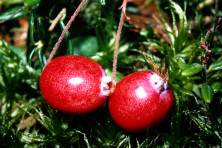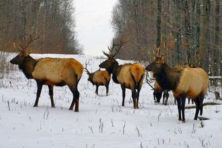Highbush Cranberry – Emergency Bird Food
- Share
- Tweet
- Pin
- Share

One Highbush Cranberry corymb is about three inches wide.
One of the first Latin names of a group of plants I learned as a boy, purely by accident, was “viburnum” – a showy “snowball” shrub having lovely white spherical clusters of flowers. One of the shrubs grew near the northeast corner of our house, and I can clearly recall my dad telling me that it was a Viburnum.
Actually, Viburnum is a fairly large genus of easy-to-grow shrubs belonging to the honeysuckle family. You may recognize some of the members such as the Hobblebush, Arrow-wood, Wayfaring Tree, Nannyberry and Maple-leaved Viburnum (a great favorite of mine).
Undoubtedly the most well-known and widely-planted Viburnum in this region is the Highbush Cranberry, also known as the Cranberry Bush and High Cranberry. Few other native shrubs have such attractive flowers in June, colorful leaves in fall, or as lovely fruit throughout fall and winter.
Every so often there will be very profuse flowering on this shrub as well as on the various other native dogwoods including the Red Osier, Gray, Silky, Alternate-leaved and Round-leaved Dogwoods. Various factors may have contributed to such a large floral display, but one thing that is reasonably predictable is there will be a bountiful crop of the flashy, red Highbush Cranberry fruit in fall, if the weather cooperates.
Apparently the fruit of the Highbush Cranberry resembles the real Cranberry in that it is red, oval and very tart. Other than that, they are not even remotely related, the real Cranberry being in the heath family.
Actually the fruit of the Highbush Cranberry is not a berry but rather a drupe, like a cherry, and has a stone rather than a seed, or seeds. Can you imagine calling the plant the Highbush Crandrupe? Neither can I! The drupes are flat, light yellow in color and have to be removed from the fruit when making them into jelly.
Charlotte and I had the unfortunate experience several years ago of accidentally hitting a Ruffed Grouse with our car and killing it. The season was late fall and the bird had been eating Highbush Cranberries. Upon impact with the outer right side of our windshield, the bird’s crop split open splattering the glass with hundreds of flat yellow seeds.
Many people who have planted these handsome shrubs, which can grow to a height of 7 to12 feet, remarked to me that they were disappointed to see the birds completely ignoring the attractive and inviting red “berries” all winter. I tell them to be patient; sooner or later this year or the next, some Cedar or Bohemian Waxwings, Robins, Pine Grosbeaks, or even Ruffed Grouse will discover the precious emergency food when few other wild foods are available.
If you own some of these shrubs and the birds have found them, you may notice that the snow-covered ground beneath them may be liberally speckled with the red flesh of the fruit. The birds tend to be more interested in the seeds and not the flesh. A long hedge of Highbush Cranberries is a thing of beauty because the fruit remains for much of the winter.
The scientific name, Viburnum trilobum (try-LOW-bum), reflects the three to five-inch leaves, which are three-lobed above the middle, resembling a maple leaf. The varying rich deep reds of the foliage in autumn are among the great pluses of this ornamental and beneficial shrub.
The flesh of the ripened fruit is reputed to produce excellent jam and jelly. I have heard the European species, V. opulus (OP-you-lus), produces a disappointing jelly at best. In the case you may be wondering which species you have growing on your property, the leaves of the native species, trilobum, or its cultivars are smooth on the underside while those of the European species, opulus, are hairy.

In autumn the clusters of red fruits are beautiful against a blue sky.
Nurseries handle a number of excellent cultivars known for their superior fruiting characteristics, including Andrews, Hahs, Hogg’s Red, Manitou, Phillips and Wentworth. If I had my choice I would stick with the native species or some of its cultivars that have been listed.
One feature of the jam or jelly that may interest you is that it has the distinctive odor of people’s feet – or “dirty socks” – as one of our friends describes it. Fortunately, it doesn’t taste like dirty socks! Adding a few slices of lemon or orange peel to the jam or jelly will remove the unusual odor.
Flowers of the Highbush Cranberry in bloom are intricate and fascinating to study. There are two distinctly different flowers on each flat-topped corymb (KOR-imb), or cluster. The outer ones are large, showy white, sterile flowers, somewhat resembling those of a hydrangea. The flashy structures are strictly for advertising, for attracting potential pollinators to the real flowers.
The fertile flowers are quite tiny and grouped tightly together in the middle of the encircling infertile advertisers. Visiting insects will walk across the tiny florets, thereby spreading pollen and ensuring that some hungry birds or other wildlife – White-tailed Deer, Foxes, Raccoons, Squirrels, Mice and Rabbits – will have valuable seeds to eat on a sub-zero February day.




